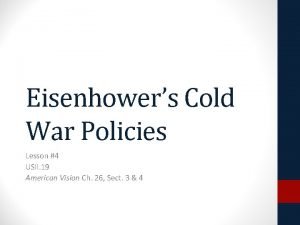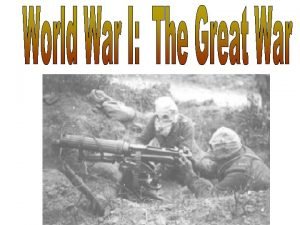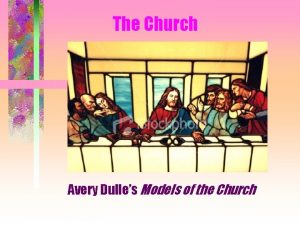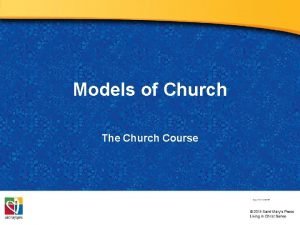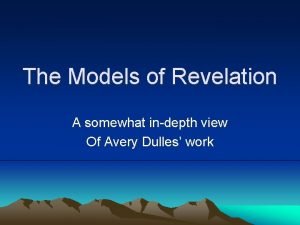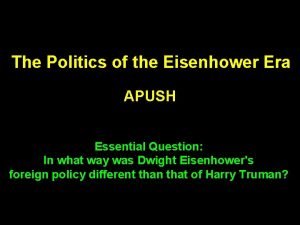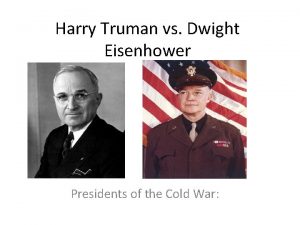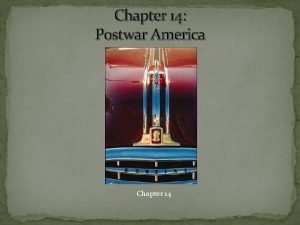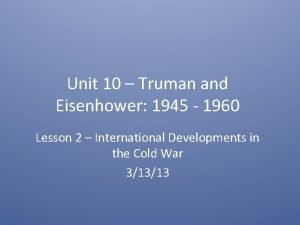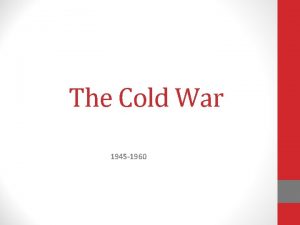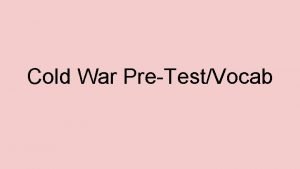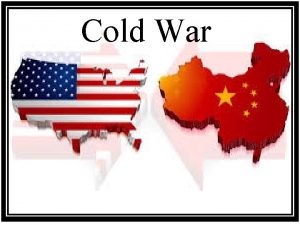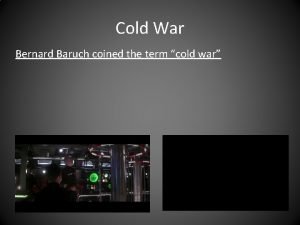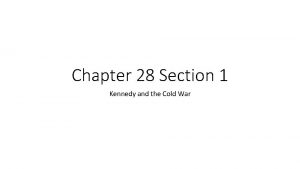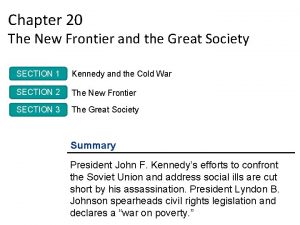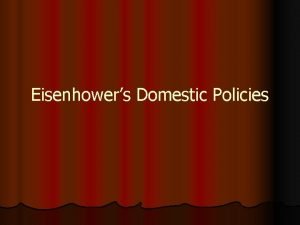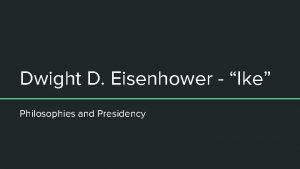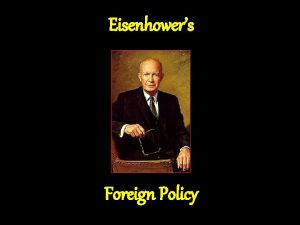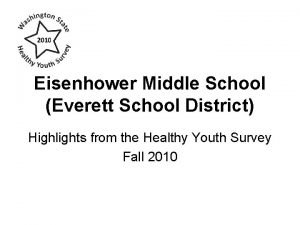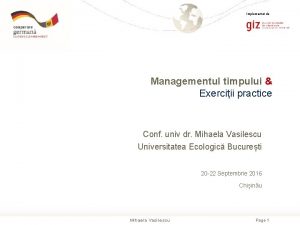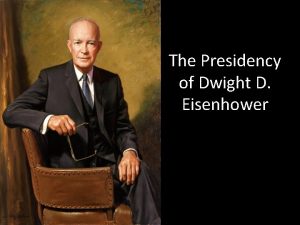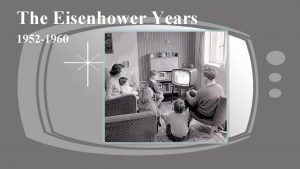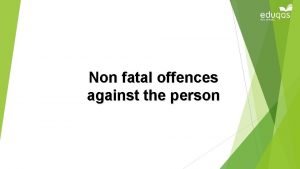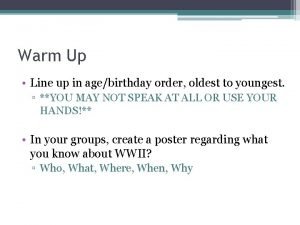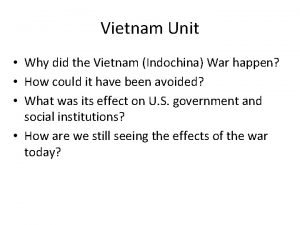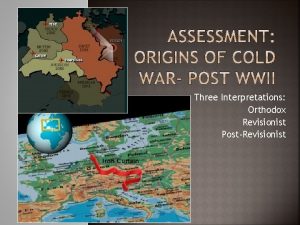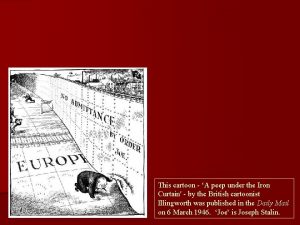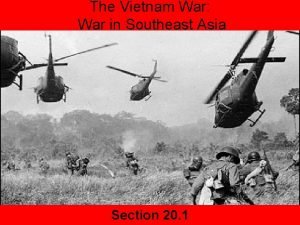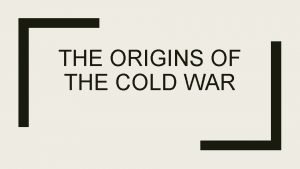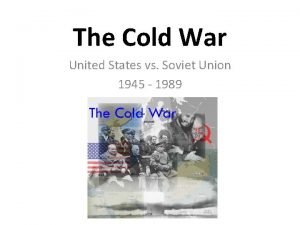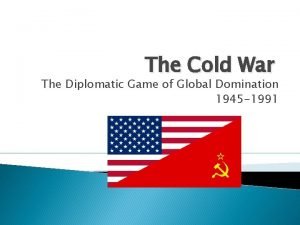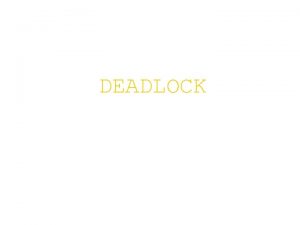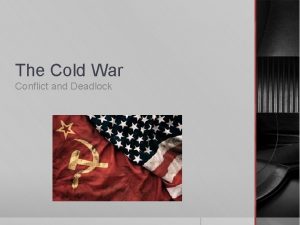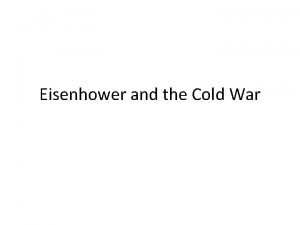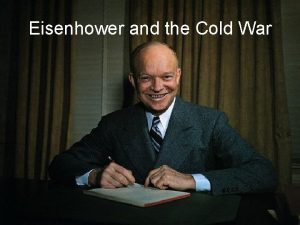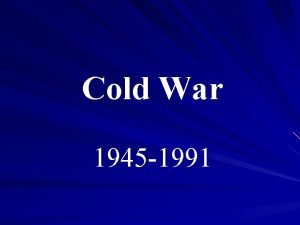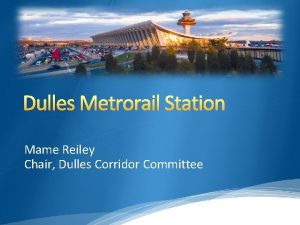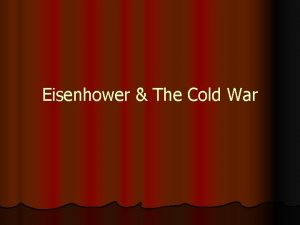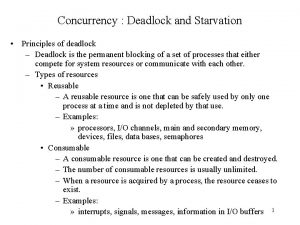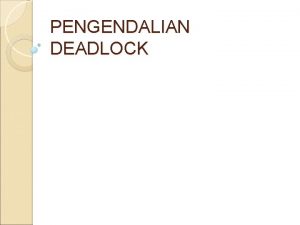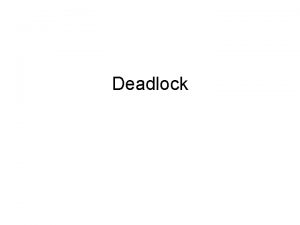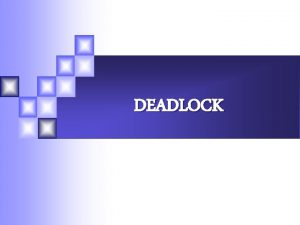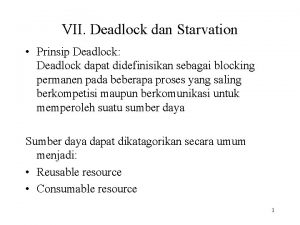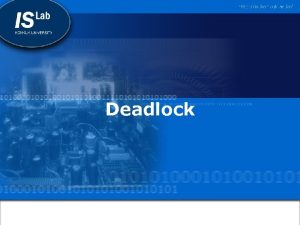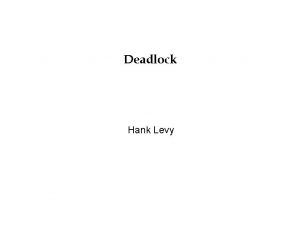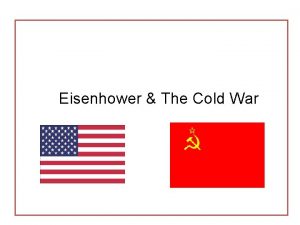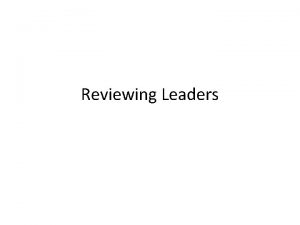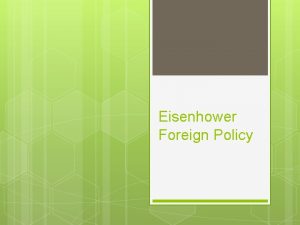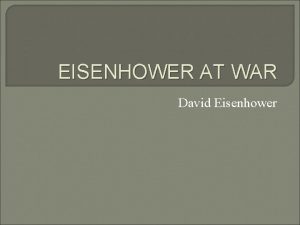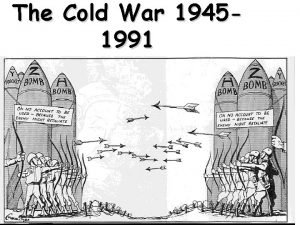The Cold War Conflict and Deadlock EISENHOWER Dulles










































- Slides: 42

The Cold War Conflict and Deadlock

EISENHOWER

Dulles & Foreign Policy § SOS = John Foster Dulles § He “saw the world as an arena in which the forces of good and evil were continuously at war. ” –British ambassador to US § A moralist and tactician, experienced, intelligent § Containment = defensive, contentment w/ status quo shift § US should promote LIBERATION of nations from Soviet domination § “New Look” military posture § Massive Retaliation = “more bang for the buck” § Nuclear weapons/air power in “limited-war” situations reduce conventional forces spend less $$ & put pressure on enemies

§ “balance of terror” replaces “balance of power” (Churchill § Policy of “brinkmanship” § ‘ 56 - to be tough & confront Communist threat, had to “go to the brink” of war § Examples§ ’ 53, Korea: US sends atomic weapon threat § ‘ 54, Indochina: US carriers into South China Sea- “both to deter any Red Chinese attack against [French] Indochina and to provide weapons for instant retaliation. ”

Indochina: The Background to War

Prelude § Nat’lism after WWII weakening/collapse of colonial empires § Early 50 s- GB, Dutch, French § US position? Support colonial nat’lists (Spirit of 1776) OR world powers that could aid in fight vs. communism § Truman aid to French/Dutch regain land lost by Japan to locals § French Indochina § WWII- opposition to Japanese led by Viet Minh (Vietnamese League for Independence) ü Nat’lists came under control of communist, rebel Ho Chi Minh ü Aid from US during war § End of war = control of N. Vietnam by Viet Minh, Democratic Republic of Vietnam (Hanoi)

§ ‘ 46 - French recognition of DRV as “free state” w/in colonial union § End of year- French to crush Vietnamese nat’lism § Opposition to French effort to establish regime in southern province First Indochina War § US involvement? § US disagree w/ restoration of French rule, but need France aid vs. communism § ‘ 48 - support to French to further “aims in Europe” more important than “realization of our objectives in Indochina. ” § Viet Minh movement dominated by Ho Chi Minh, Communists § Dependent on Soviet Union, China

§ ‘ 50 - Korea War Vietnam another battleground? § Truman- aid to French § ‘ 53 - truce in Korea increased aid to French under Ike ü 2/3 cost of French cost § ‘ 54 - French loss to Viet Minh @ Dien Bien Phu § Draw out guerillas in open, crush w/ superior weapons § OOPS…surrounded, besieged § French request US air strike in March US refused § April 7, ‘ 54 - Ike’s DOMINO THEORY § Opposition to direct involvement alone

§ May, ‘ 54 - Viet Minh attacks overwhelm French, defeats con. § July 20, 1954 - agreement on Geneva Accords Final Declaration § Viet Minh control N @ 17 th parallel, French control S ü Elections in ‘ 56 to unite Vietnam ü Neither US, nor South Vietnamese join in accord or sign FD § Laos, Cambodia neutral

§ US response? “Pactomania” (43 by ‘ 60) § Dulles organize mutual defense agreements for SE Asia § September ‘ 54 - US + 7 = Southeast Asia Treaty Org. (SEATO) ü Philippines, Thailand, Pakistan, GB, Fr, Australia, NZ, US § NOT another version of NATO ü Response by nations in accord to their “constitutional practices” ü In case of threat, subversion- would “consult immediately” ü Special protocol included converage to Indochina

§ Ike announcement on Vietnam, ’ 54 § US no part of decision @ Geneva, but Communist aggression “would be viewed by us as a matter of grave concern. ” ü US did agree NOT to use threat or force to disturb agreements put in place

§ HCM & gov. consolidate control in North § Kangaroo courts to seize land § Leave N w/ US aid (900 k refugees into South) problems for weak SV gov. § SV power to Ngo Dinh Diem (Catholic nat’list opposed to French & Viet Minh) § Ike offers assistance “in developing and maintaining a strong, viable state, capable of resisting attempted subversion or aggression through military means. ” § US expectation? Democratic reforms, land to peasants § US aid = CIA, military cadres to train

§ Diem tightened control by suppressing opposition; no land distribution; widespread corruption § ‘ 56 - refusal to participate in elections on reunification of Vietnam (US backed) § Communists use efforts to tighten control recruit SV who are discontented with Diem, gov. § ‘ 57 - SV guerrilla forces sympathetic to HCM, communism = Viet Cong § Attacks on Diem gov. § ’ 60 - resistance moves to political faction: National Liberation Front

Kennedy and Vietnam

Growing Conflict § Policy? § Flexible response- NOT massive retaliation/nukes § Increase $$ to conventional arms, mobile military forces, special forces § Laos neutral/independent by ‘ 54 Geneva Accords § Power struggle b/t Communist Pathet Lao insurgents (Soviet backed) vs. Royal Laotian Army § Options? § “You might have to go in there and fight. ” = direct intervention § Decision to back formation of neutral coalition gov. – May ‘ 61 § Would include reps from Pathet Lao § No military intervention + No Pathet Law victory = WIN

Meanwhile, back in N. Vietnam. . . § HCM Trail open through E. Laos to supply Viet Cong § South Vietnam struggles § Ngo Dinh Diem repressive tactics to retain control , no democracy, no social/political reform, action vs. Buddhists, Communists § 1961 - US sends emissaries to Saigon § Walt Rostow, Gen. Maxwell Taylor § Proposition? Increase in US military presence § JFK refused, sends more advisers ü 1961 - JFK into office, 2 k US troops ü 1963 - 16 -17 k troops, none committed to battle

§ Worst enemy? Diem regime by mid-’ 63 § Public discontent w/ regime visible- Buddhist monk demonstrations in streets vs. “iron-fisted rule” of Diem § Fall ‘ 63 - Diem = “lost cause” § SV generals launch coup d’etat on Nov. 1 & seize gov. , murder Diem § successive coups by military leaders

The Tragedy of Vietnam

Escalating Issues § Not a major issue in ‘ 60 election- US involvement minimal § Under JFK § Adopted Domino Theory, aid to SV (also, advisers), training of troops, guarding of weapons/facilities, “strategic hamlets” (fortified villages) § ‘ 63 = 16 -17 k troops- role was SUPPORT, NOT COMBAT

LBJ & the Tonkin Gulf Resolution § Reason for “escalation” § Aug. 7, ‘ 64 - 2 US destroyers attacked by DRV on Aug. 2 & 4 in Gulf of Tonkin § Provoked? § Resolution Pres. authorization “to take all necessary measures to repel any armed attack against the forces of the United States and to prevent further aggression. ” § Decision time- Feb. 5, 1965 = “Americanization” of the war § Viet Cong guerillas kill 8/wound 126 Americans, more attacks later in week § Order of Operation Thunder to stop soldiers/supplies from getting to south § August- task force reports bombing unsuccessful, but attacks continue


§ March, ‘ 65 - Gen. William Westmoreland request/gets first group of combat troops to defend US airfields § End of ‘ 65 - 184 k troops, ‘ 66 - 385 k § Combat operations increase in SV casualties increase § Announced on news (“body count”) § “Westy’s War” = helicopters, gunships, chemicals, napalm § war of attrition § No declaration of war by Congress, but full-scale use of US forces § Congress gave Pres. Authority to use troops, never recalled § Support through ’ 68

Policy § LBJ decision consistent w/ other US presidents since WWII § Containment- Truman Doctrine endorsed by Ike, Dulles, JFK § US pledged to oppose advance of communism anywhere in world § “Why are we in Vietnam? We are there because we have a promise to keep. . . To leave Vietnam to its fate would shake the confidence of all these people in the value of American commitment. ” –LBJ § SOS Rusk promotes domino theory as reason to stay involved § Military intervention logical

§ LBJ know not to let military involvement get to levels to provoke China or Soviets LBJ control over bombing, restrictive policy of leadership § Sign that victory not possible § US goal not victory by capturing territory § Goal to prevent North Vietnamese/Viet Cong from winning, hope to force settlement § Problem? § US support faded faster than North Vietnamese toleration of casualties § US fighting limited war for limited objectives § N. Vietnamese fighting total war for survival

Opposition § Opposition on college campuses in ’ 65 (year of escalation) § Investigation into US policy in Vietnam by Senate FR Committee § Led by Sen. J. William Fulbright (AR) § Kennan felt policy OK for Europe, NOT for SE Asia § Anti-war demonstrations in NY, @ Pentagon in ‘ 67 § Vietnam 1 st war with extended TV coverage = “living room war” § “The picture of the world’s greatest superpower killing or injuring 1, 000 noncombatants a week while trying to pound a tiny backward nation into submission on an issue whose merits are hotly disputed, is not a pretty one. “ – Robert Mc. Namara



Misinformation § Misinformation from military/civilian leaders + LBJ avoiding true cost/scope of war “credibility gap” § Also w/in gov. , understanding of enemy or nature of war also slowed § Early ‘ 68 - US forces on verge of gaining upper hand vs. Communists display of cunning/tenacity against US § Tet Offensive § LBJ’s hope? Increase military pressure DRV would come to peace table


Hawks vs. Doves § Hawks = war supporters § Soviets influence over NV Communists vs. SV, plan to take over SE Asia § Doves = anti-war § Civil War- no place for US § High cost of life, $$ § College students- draft issue

The Turning Point § Jan. 31, ’ 68 = start of TET Offensive § Tet – 1 st day of New Year § Holiday truce waved, wave of surprise attacks by NV & VC § Attacks in SV occupation of US embassy in Saigon for several days § Counterattack by US/SV massive casualties of NV/VC § 200 k more troops § Effect? Psychological § Contradiction to upbeat claims by US commanders about ground war § increase anti-war/withdrawal campaigns § LBJ popularity down to 35% § $322 k/soldier, $53/person in poverty


LBJ § ‘ 68 - turns to isolation § Depression, paranoia § Reports that victory not viable prospect § Undermining Great Society programs § Dem. Party fragmenting § Bobby Kennedy for President? An option vs. LBJ § Sen. Eugene Mc. Carthy (MN)- student vote, anti-war (42% in NH)

§ March 31 - limited halt to bombing, new attempt @ negotiations § END to quest for victory § Now? How to extricate with minimal damage to prestige § Paris- May, ’ 68: discussions w/ NV end when demand final end to US bombing § BUT- end to “escalation”- no more troops § PS. . . § “I shall not seek, and I will not accept, the nomination of my party for another term as your President. ”

NIXON

Nixon and Vietnam § 50%+ of US troops in Vietnam § Nixon + Henry Kissinger (Nat’l Security Adv. ) = new plan for “peace with honor” § 3 areas of focus: § Paris peace talks: US demand NV withdrawal, recognition of US backed SV gov. deadlock secret meetings b/t Kissinger & NV § Defuse domestic unrest Via “Vietnamization”- turn combat missions over to SV units, reduce US ground forces, $/weapons/training to SV (‘ 69 - 560 k, ‘ 73 - 50 k) § Expansion of air war effort Pressure NV to come to terms March 18, ‘ 69 - Operation Menu- 14 months of bombing Cambodia SECRET- not known by Congress until ‘ 70

Division at Home § Slow withdrawal of military low morale, reputation of troops § “No one wants to be the last grunt to die in this lousy war. ” § “fragging” = troops vs. officers (fragmentation grenades) § Drug abuse- 4 x more hospitalized for overdose than combat wounds (’ 71) § Leaked reports of atrocities § My Lai, Pentagon Papers

Antiwar Opposition § By ‘ 70 - Reaction to Nixon’s war effort § My Lai massacre, ‘ 68 (Army Lt. William Calley, 200 Vietnamese civilians) § College wide protests , violence/shooting (Kent State- 4 dead, Jackson State- 2 dead) § Pressure from activists, escalation in reaction repeal of Gulf of Tonkin Resolution § 1971 - US learn about slaughter of women/children by US in Vietnam (‘ 68), antiwar sentiment from NYT, revelation of “Pentagon papers” with history of mistakes/deceptions of gov. in dealing w/ Vietnam (released by Daniel Ellsbert, DOD) § ‘ 64 on- plans for expansion of war effort, US entry (LBJ)


From War to Peace. . . Talks § Tactical success in Cambodia § SV troops struggle to replace US forces (defeats ‘ 71 -’ 72, disorganized, poorly led) reliance on US air power § By ‘ 72 - Kissinger (SOS, ‘ 73) + NV foreign minister on cease-fire § Agreement drops removal of ALL NV troops from SV § Summer ‘ 72 - peace at hand. . . but SV won’t compromise § B-52 bombing of NV for several weeks = “Christmas bombings & jugular diplomacy”

Paris Accords- Jan. 27, ‘ 73 § NV agreement to armistice § NV retain request for: 150 k troops in S, idea of unified Vietnam ü Fighting between NV/SV continues ü By April 30, ‘ 75 - Communist forces take Saigon (Ho Chi Minh City) § Shift from ‘ 72 was SV acceptance of terms ü Why? US promise to respond “with full force” if violation of agreement § US withdraw remaining troops, receive 500+ POWs, § Cease-fire, free elections

Legacy § March 29, ‘ 73 = last US combat troops leave Vietnam ü MIA in thousands ü $150 b. spent on war, 58 k US death § Democracy not easily transferred to third-world nations § No history of liberal values, no rep. gov. § Lack of respect for military service § Division among American society § Reaction? noninterventionist foreign policy
 Lesson 4 eisenhowers cold war policies
Lesson 4 eisenhowers cold war policies The cold war lesson 1 the cold war begins
The cold war lesson 1 the cold war begins Cold war conflict
Cold war conflict Cold war sides
Cold war sides Mystical communion model of the church
Mystical communion model of the church Model of the church
Model of the church Washington flyer taxi
Washington flyer taxi Models of revelation
Models of revelation Eisenhower apush
Eisenhower apush Truman vs eisenhower
Truman vs eisenhower Lesson 1 truman and eisenhower
Lesson 1 truman and eisenhower Lesson 1 truman and eisenhower
Lesson 1 truman and eisenhower Cold war cause and effects
Cold war cause and effects Pretest communism and the cold war
Pretest communism and the cold war Communist and capitalist countries cold war
Communist and capitalist countries cold war Who started the cold war and why
Who started the cold war and why Section quiz chapter28 kennedy and the cold war
Section quiz chapter28 kennedy and the cold war Chapter 20 section 1 kennedy and the cold war
Chapter 20 section 1 kennedy and the cold war External conflict
External conflict What is conflict and conflict resolution?
What is conflict and conflict resolution? One subcategory of external conflict is
One subcategory of external conflict is Matriz de eisenhower excel baixar
Matriz de eisenhower excel baixar Dwight d eisenhower domestic policy
Dwight d eisenhower domestic policy Eisenhower philosophy
Eisenhower philosophy Stalingrad csfd
Stalingrad csfd Presidential and congressional reconstruction venn diagram
Presidential and congressional reconstruction venn diagram Truman foreign policy vs eisenhower
Truman foreign policy vs eisenhower Dwight d eisenhower accomplishments
Dwight d eisenhower accomplishments Eisenhower middle school everett
Eisenhower middle school everett Metoda eisenhower
Metoda eisenhower Eisenhower
Eisenhower The eisenhower years, 1952-1960
The eisenhower years, 1952-1960 Matrice di eisenhower excel download
Matrice di eisenhower excel download Non fatal offences evaluation
Non fatal offences evaluation Toward civil war lesson 3 secession and war
Toward civil war lesson 3 secession and war Cold war acrostic
Cold war acrostic Operation rolling thunder cold war
Operation rolling thunder cold war Cold war
Cold war Who is peeping under the iron curtain
Who is peeping under the iron curtain Operation rolling thunder cold war
Operation rolling thunder cold war Causes of cold war
Causes of cold war The cold war thaws worksheet answers
The cold war thaws worksheet answers Effects of cold war
Effects of cold war
